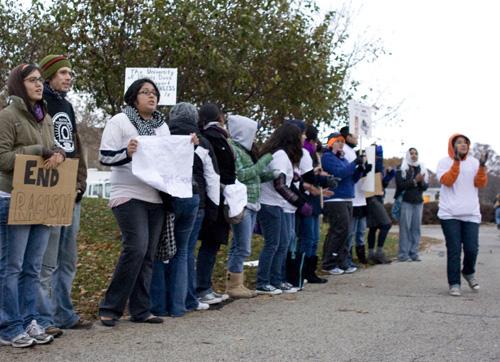‘Next Dance’ sees praise and protest

Erica Magda
November 17, 2008
An estimated 9,000 people gathered in the Assembly Hall Saturday for the “Next Dance,” a controversial event organized by the Registered Student Organization Students for Chief Illiniwek.
Outside of the hall, about 30 opponents gathered to protest the event, which featured a return performance of the retired University symbol, while police officers stood guard to ensure a safe environment.
The event marked the first time since the “Last Dance” on Feb. 21, 2007, that the Chief had been seen or had performed, although Saturday’s program was not endorsed by the University.
“While the University of Illinois officially retired the Chief as a symbol of the University in February of 2007, it can never retire the values for which it stands,” said Roberto Martell, president of the RSO.
The performance by the current portrayer of the Chief, Logan Ponce, deviated slightly from the last time the Chief performed. The Chief wore moccasins on Saturday, while in February of 2007 he was still performing barefoot. The dance was also slightly altered since 2007 by replacing some of the acrobatic elements with stomps that were used in the earlier years of the tradition.
“I really wanted to do this as best as I could, just with the adrenaline of the day, the excitement of the day, the support leading up to it, it was extremely exciting to be out there,” Ponce said. “I was just thinking it was amazing that we’re here now, people were having a less positive view of things two years ago, and just the fact that we were able to do this is so exciting for us.”
Speakers at the event and the multimedia presentation highlighted the history of the dance.
“The significance of the Chief is in what it represents,” said Bill Forsyth, who portrayed the Chief from 1984 to 1985. “It represents all that is good and human; it is a wonderful and timeless symbol.”
For Pro-Chief activists, the event was a celebration of the long-standing tradition of the University, but there was also focus from some of the speakers toward renewing the Chief tradition.
“This is not the end; it is only the beginning,” Martell said.
Seeing the Chief for the first time in almost a year and a half provoked emotional responses from some of the audience members.
Springfield resident Sally Chernis argued the lopsidedness of supporters to protestors at the event demonstrated a strong pro-Chief population on campus.
“There’s like 30 people out here compared to the 9,000 inside,” Chernis said. “We love the American Indians. We’re trying to honor them, not degrade them.”
Ruth Sierra, a senior in ACES, organized the rally against the Chief, which originated as a Facebook event that publicized the protest.
“A lot of us are not Native Americans, but racism is still wrong,” Sierra said. “(Student Trustee) Paul Schmitt said himself that the Chief isn’t supposed to be accurate. Well, right, but it’s still a stereotype.”
Two male protesters wore black face paint to represent minstrel shows, an American entertainment sketch performed by white actors in blackface around the mid-to-late 19 century. The protesters, as an entirety, shouted “No more minstrel shows.”
“If another group wanted to perform in blackface at Assembly Hall, the University wouldn’t allow it, so why would they allow this to happen on their property?” said protester Courtney Cutheertson.
Vanessa Gutierrez, senior in LAS, said that although the Chief has been retired by the University, it is still important for opponents of the mascot to be visible.
“If we let this go on without our voices being heard, people are going to come in and forget why there is an anti-Chief movement,” said Vanessa Gutierrez, senior in LAS. “Obviously there is a big support for Chief Illiniwek at the University, but it seems that people don’t understand how students of color see this image as a racist image.”
Protester William Cook held a sign that read “Cleveland Caucasians” with an illustration of a Caucasian man clenching straw in between his teeth.
“I’m just trying to get people to think about this with a clear conscious,” Cooke said. “I know it’s hard to do because everybody believes it’s okay, and that’s the problem. They believe what they hear instead of actually doing much thinking.”
Only two or three Chief advocates initiated a stable conversation with the protesters, and Sierra said fluid communication can be key to understanding each other’s differences.
“We’re out here so future and uneducated students know that standing for the Chief is not the only option,” Sierra said. “There needs to be more understanding of the issue.”
Some notable attendees of the event included Aaron Shock, Congressman-elect from Peoria, Ill.; state Rep. Chapin Rose, R-110; University of Illinois Trustee David Dorris; and student body president Jaclyn O’Day.
“If the Chief is only about four minutes at halftime, the critics who call us ‘mascot lovers’ are right,” said Roger Huddleston, president of the Honor the Chief Society. “As long as you continue to make this more than four minutes at halftime, the Chief will live forever.”




 DI multimedia
DI multimedia



